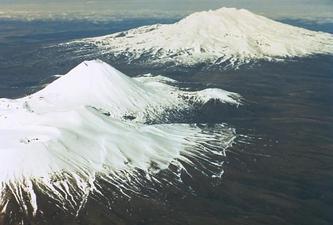 From the GVP website, the Tongariro complex is at the front. Tongariro is a volcanic complex, which is shown in the picture to the right in the foreground, with Ruapehu behind. On the 20th November it had its second significant explosion of 2012 from the Te Maari crater (video below). Historically Tongariro (from current centre of activity Ngauruhoe) and the nearby Ruapehu are the most active in New Zealand. Tongariro last erupted in 1977 in a very small eruption classified as VEI 1 and generally throughout history it has experienced little strong activity above VEI 3, an exception being a VEI 5 event a few thousand years ago. It is highly likely therefore that the current period of inactivity will follow the same trend. After finding the below video from the recent Eruptions blog post, I thought it would be a nice idea to discuss briefly what is potentially occurring in the conduit for the duration of this video. It is not often that you have videos as good as this (click the read more button on the right!). 00:00 to 00:43 - There will likely be a large build up of gas beneath the crater/vent. As the gas builds up it begins to fragment the magma into a foam (this can happen over longer periods than in the video), building the pressure. The term foam means that there is a very high ratio of gas to magma making the magma clots very small. Eventually, the cap fails, releasing the pressure on top of the magma column (often called overpressure). 00:43 - The eruption occurs and the pressure release causes an eruption cloud to form. The initial cloud is very ash-rich as a result of the large amount of fragmented magma at the beginning of the eruption and as a result of the destruction of any cap. 00:43 to ~06:00 - Continued gas (also known as volatiles) and heat supply keeps a plume in place. However, with time the amount of ash in the plume decreases. 06:00 - onwards - The heat keeps a visible discharge of steam coming from the summit, which rises because of its temperature. Pressure has been equalised somewhat, another eruption will occur when pressure build up is enough to cause a failure at the summit. Comments are closed.
|
Archives
July 2023
|

 RSS Feed
RSS Feed